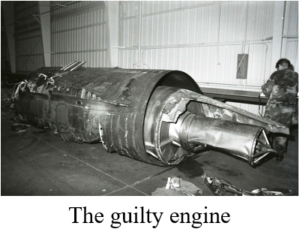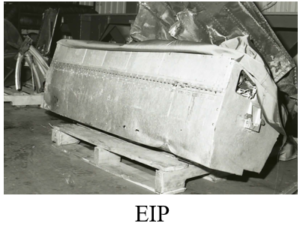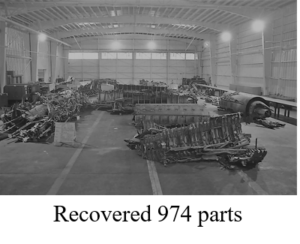The operation at Kadena was known by several names. I think the there are several web sites that list them. For us it was Det One or Ichi Ban (number one).
When I first arrived on Okinawa Ron Badamo assumed that I would become the site manager, a job he had been doing for several years. I assured him that I did not want the job and made that clear to the Program Office and to the people at Beale. I did not want to write weekly reports, handle time cards and answer phones, I wanted to spend any spare time with Jan, eventually diving and touring.
I did not suspend my programming during my time at Kadena. It became necessary several times to ‘alter’ the data to facilitate processing. During processing of one particular mission the analysts noticed that no emitter ‘fixes’ were coming from data in one band on one side. I looked at the data and determined that the course and extra fine data seemed to be reversed. While the mission was being processed I rewrote a couple instructions in one of the analysis programs that processed pulse level data. After all the other data was processed I reprocessed the offending data only, switching the course and extra fine data and reprocessed it. The fix worked, and the remaining data was reported.
I went to the field shop and talked to Ron Badamo and asked him if the RF cable lines had been worked on since the previous mission. He indicated that they hadn’t and that the system was going to stay ‘uploaded’ for the next mission. I showed him the data and how the software fix solved the problem and he reluctantly had the offending side downloaded and found that the lines had indeed been switched. This was the advantage in having the hardware and software produced by the same company. No time is wasted fixing the blame rather than fixing the problem. The cooperation was what made the fix timely. It took less than an hour to find and correct. Ron was a great site manager.
During the Iran Iraq War in the late 1980s there was concern about Chinese ‘silkworm’ anti-ship missiles being deployed by Iran threatening the Strait of Hormuz. Look it up; it’s a narrow section at the southern end of the Arabian Gulf. Kadena was tasked to fly a mission to investigate. This would be a very long and extended mission requiring many re-fuelings with the final legs consisting of a ‘tanker drag’. When the SR71 would have to fly at essentially KC10 speed and altitude. This was caused by the limitation of the amount of nitrogen that the SR71 was able carry to enable it to pressurize the fuel tanks at altitude. After the pre-mission checkouts were completed and the SR71 took off there was a long wait for their return. These became 11 hour flights. I think that there were 4 flown and all were successful.
The camaraderie of the SR71 group at Det 1 was evident. We all worked together and spent a lot of off time together, swimming, diving, picnicking, and touring Okinawa.
One incident is forever etched in my memory. On 21 April 1989, a Thursday, an SR71, tail number 974 (Ichi Ban) crashed just off the northern end of Luzon Island of the Philippines. The crew members were Dan House and Blair Bozek. It was at operational speed and altitude when one of the jet engines started coming apart.  Dan, the pilot, got the SR71 down low and slow enough for a safe ejection. Both crew members landed some 200 yards off shore and were picked up by some Philippine fishermen and taken to their village.
Dan, the pilot, got the SR71 down low and slow enough for a safe ejection. Both crew members landed some 200 yards off shore and were picked up by some Philippine fishermen and taken to their village.
During the whole time all the command and support personnel were huddled in the radio room waiting word of their condition. I don’t think I have ever prayed so much for friends as I did that afternoon. It was quite a few hours until we knew they were safe and not injured. It should be noted that prior to takeoff, Dan and Blair had planned to have a party in the crew ‘party room’ in the BOQ on Saturday the 23 of April. They returned to Kadena and hosted the party and had quite a story to tell of their rescue and finally being picked up by helicopter and flown back to Kadena. Their tale of crash and rescue is probably told in other pages on the internet and I will not attempt to relate it.
The wreckage of the SR71 was recovered from the ocean floor. It was in about 120ft of water and the navy sent an experienced search and recovery task force to the crash area. The parts were loaded onto a barge and transported to White Beach (US Navy facilities on Okinawa) and then loaded onto trucks to bring it back to Kadena. One of the bigger challenges was to cut some of the larger pieces into smaller chunks so they could be transported by truck on the roads of Okinawa. The SR71 structure was mostly titanium and cutting it into pieces

requires special techniques and tools. Once it was back on the base at Kadena it was put in bay 4 of the T-hanger.  Ron Badamo and I spent several hours taking pictures of the parts especially the EIP.
Ron Badamo and I spent several hours taking pictures of the parts especially the EIP.
I don’t know what the final resting place was for the remains of the SR71 but think it was dumped in some deep part of the ocean rather than buried.
After take-off of one mission, it may have been one going to the mid-east area, there was a report through Intel that a Russian bear bomber had flown over Okinawa at the time of take-off. Interesting how they would have known the schedule, but I am sure there were sufficient resources available to spy on the operations.
Sometime during 1988-1989 we got word that the program was going to be shut down. The Det commander, Col Lee Shelton called an ‘all hands’ meeting to explain the situation. After his briefing he asked all enlisted and civilians to stay for a presentation by Dave Adrian (Magnavox, Radio contractor) and myself. Then all the officers left the meeting. Dave and I had prepared a letter to the representatives and senators urging them not to shut down the program. The letter listed all the reason we could think of for keeping the program open. We had a list of all the reps and senators for each state so anyone desiring, could send a copy of the letter to their rep and senators. We also had purchased the necessary stamps for postage. Almost everyone sent a letter. Somehow, we did not get canceled at the end of the yearly contract, but it was soon afterward. I have no idea if our letter writing had any influence in delaying the shutdown, I do feel better that we tried.
It should be noted that once the SR71 had been shut down in January 1990, Iraq invaded Kuwait August 1990. US Central Command (CentCom), requested that an SR71 fly over the area to provide timely information on Iraq’s level of incursion into the Kuwait. After all, when SAC sold the idea of the shutdown to Congress it stated that the SR71 would be in ‘Flyable Storage’. NOT!

I was at Castle AFB when an SR-71 was flown in to be put in their museum. As soon as it landed it was taken to an area at the end of the runway, the engines were drained of oil, and then run until they seized. Then the main wing spars were cut. They made very sure that it would never, ever fly again.